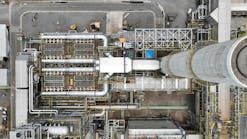Royal Dutch Shell PLC has entered a deal to sell nearly all of its interest in Japanese refiner Showa Shell Sekiyu KK to Idemitsu Kosan Co. Ltd. as part of the company’s ongoing strategy to reduce its downstream refining assets. As part of the agreement, Idemitsu Kosan will buy Shell’s 33.24% majority interest in Showa Shell Sekiyu for about $1.4 billion, Shell said on July 30 (OGJ Online, July 30, 2015).
Shell will retain, through its subsidiary Anglo-Saxon Petroleum Co. Ltd., a 1.8% ownership interest in Showa Shell Sekiyu, according to a July 30 regulatory filing by the Japanese operator.
Shell said it expects to finalize the deal in 2016, pending regulatory and contractual approvals.
The divestment, which includes majority ownership in Showa Shell Sekiyu’s three Japanese refineries, aligns with Shell’s strategy to concentrate its downstream footprint on a smaller number of assets and markets where it can be most competitive, said John Abbott, director of Shell’s downstream operations.
The company, however, has no plans to exit Japan entirely.
Shell intends to continue its partnership with Showa Shell in other Japanese downstream business ventures, including lubricants, chemicals, and trading.
Japan also remains an important LNG market for Shell’s upstream integrated gas business, the company said.
Shell’s sale of Japanese refining assets follows Shell Australia’s announcement last year of the sale of its 118,000-b/d Geelong refinery in Victoria and its network of 870 retail outlets across the country to Dutch group Vitol (OGJ Online, Feb. 21, 2014).
In 2012, the company closed its 79,000-b/d Clyde refinery at Sydney (OGJ Online, June 7, 2012) after selling refineries in the UK and some mainland European countries, as well as other downstream divestments in Italy, Egypt, Spain, Greece, Finland, and Sweden.
Earlier this year, Shell Refining Co. (FOM) Bhd. (SRC), a Shell holding, said it is evaluating either the potential divestiture or closure of its 125,000-b/d Port Dickson, Malaysia, refinery (OGJ Online, Jan. 14, 2015).
Following a structured review of SRC’s resilience in a persisting poor-margin environment, the company’s board continues to investigate long-term options which include, but are not limited to, sale of the refinery or its conversion to a storage terminal.
That structured review remains ongoing, SRC said in its latest filing with Bursa Malaysia.
Showa Shell Sekiyu refineries
Showa Shell Sekiyu holds the majority interest in three subsidiary-run refineries in Japan that have a combined crude oil processing capacity of 445,000 b/d, according to company’s latest operations report.
The Keihin refinery, in Kawasaki, Kanagawa prefecture, is operated by Toa Oil Co. Ltd., and has the following unit processing and production capacities:
• Atmospheric distillation, 70,000 b/d.
• Vacuum distillation, 58,000 b/d.
• Fluidized catalytic cracking (FCC), 42,000 b/d.
• Diesel hydrodesulfurization (HDS), 20,000 b/d.
• Vacuum diesel HDS, 46,000 b/d.
• Kerosine HDS, 15,000 b/d.
• Naphtha HDS, 17,000 b/d.
• Naphtha cracking HDS, 7,000 b/d.
• Continuous catalyst regeneration (CCR) reforming, 9,500 b/d.
• Coker naphtha scrubbing, 2,500 b/d.
• Isomerization (ExxonMobil Isosieve process), 6,000 b/d (2,500 b/d).
• Flexicoking, 27,000 b/d.
• Hydrogen, 930,000 cu m/day.
• Low-calorie gas scrubbing, 5.13 million cu m/day.
• Sulfur recovery, 380 tonnes/day.
• Light catalytic-cracked gasoline scrubbing, 10,000 b/d.
• Heavy catalytic-cracked gasoline scrubbing, 16,000 b/d.
• Polynaphtha, 518 tonnes/day.
• LPG hydrofining, 400 tonnes/day.
• Solvent manufacturing, 750 tonnes/day.
• Propanel propylene splitting, 345 tonnes/day.
Operated by Showa Yokkaichi Sekiyu Co. Ltd., the Yokkaichi refinery, in Yokkaichi, Mie prefecture, completed an expansion project to boost capacities at two of its crude distillation units in February 2014, the company said.
The refinery, which increased its crude processing capacity to 255,000 b/d from a previous 210,000 b/d, also includes the following unit processing and production capacities:
• Vacuum distillation, 105,000 b/d.
• FCC, 61,000 b/d.
• Kerosine-diesel HDS, 103,500 b/d.
• Vacuum diesel HDS, 40,000 b/d.
• Naphtha hydrotreating, 69,000 b/d.
• Residue HDS, 45,000 b/d.
• CCR reforming, 60,800 b/d.
• Isomerization, 10,000 b/d.
• Alkylation, 17,000 b/d.
• Catalytic-cracked gasoline HDS, 21,000 b/d.
• Solvent deasphalting, 9,800 b/d.
• Solvent extraction, 10,500 b/d.
• Solvent dewaxing, 6,000 b/d.
Operated by Seibu Oil Co. Ltd., the 120,000-b/d Yamaguchi refinery, in Ube, Yamaguchi prefecture, also includes the following unit processing and production capacities:
• Vacuum distillation, 44,000 b/d.
• FCC, 28,000 b/d.
• Kerosine-diesel HDS, 62,000 b/d.
• Naphtha hydrotreating, 34,000 b/d.
• Residue HDS, 51,500 b/d.
• CCR reforming, 46,000 b/d.
• Isomerization, 6,800 b/d.
• Catalytic-cracked gasoline HDS: 13,000 b/d.
Contact Robert Brelsford at [email protected].
